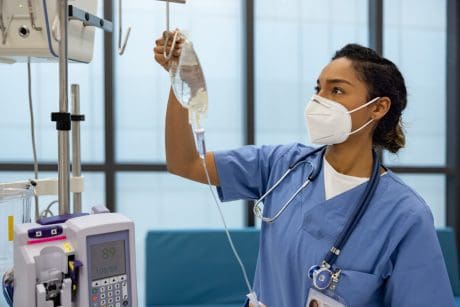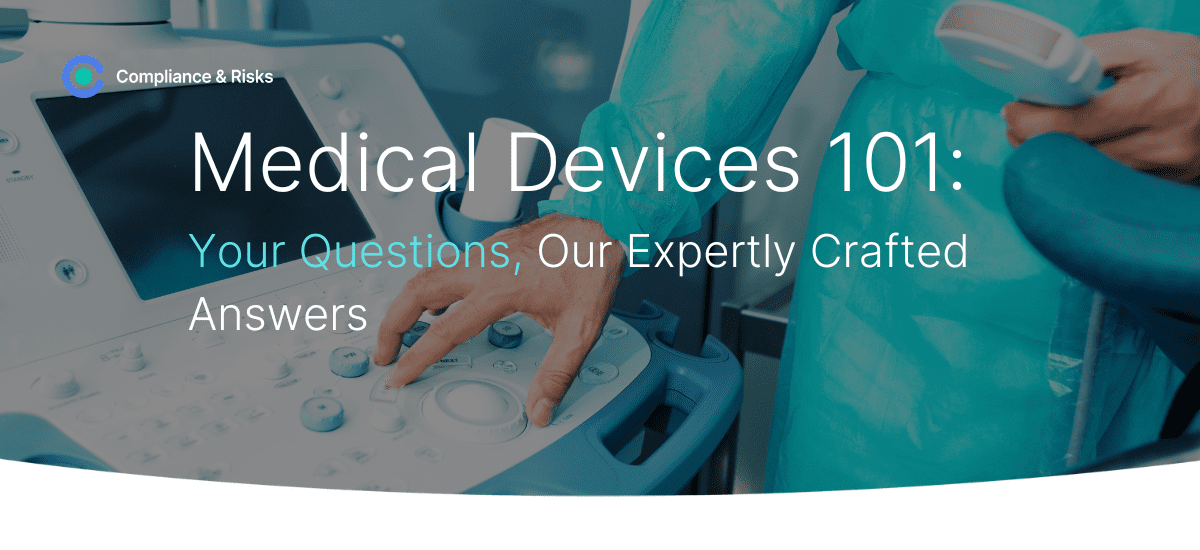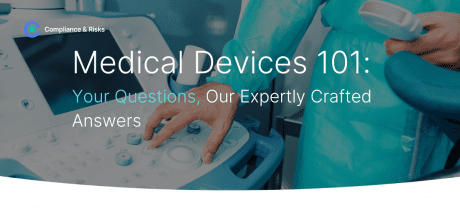
Medical Devices 101 | Your Questions | June 2023

Medical devices face a unique regulatory landscape that has been increasingly complicated by several factors in recent years.
The demand for more sustainable technology is being driven by both consumer demand and legislators, leading to regulatory implications. Global events such as Brexit and COVID-19 have also created unprecedented challenges.
As devices become increasingly integrated with artificial intelligence and an internet connection, new cybersecurity and data protection legislation is racing to keep up.
And on top of all this, the new regulatory framework for IVDR and proposed amendments for the registration, and inspection of medical devices under MDR means staying ahead is more critical than ever.
In our new series, we gather some of the most interesting recent inquiries from Compliance & Risks customers regarding the medical device regulatory updates globally:
Question 1: What are the label requirements for South Korea for a point of care IVD analyzer, where should the approval number appear (IFU, Packaging, Device Label)?
Denise McDermott , Senior Regulatory Compliance Specialist answers:
As per the South Korea Act on In Vitro Diagnostics, Article 14 (Information on outside packaging),the manufacturer or importer shall input the same information on external container or packaging if the information given under Article 13 on the container or external material of the in-vitro diagnostic medical device is not visible due to packaging or external container.
Information in Article 13 includes the following:
- Information under Article 20 of the Medical Devices Act (except for information required under Article 20(6).)
- Purpose of use
- Marking of “in-vitro diagnostic medical device”
- Method of keeping and storage, and
- Other matters determined by Ordinance of Prime Minister
Furthermore, Article 5 of the South Korea Act on In Vitro Diagnostics, (actions on the information to be written on container) container, packaging or attachments where information required by Article 22 to 22 of the Medical Devices Act at the timing of the enforcement of this Act can be used for 2 years from the enforcement of this act despite provisions from Article 13 to 15.
As per article 15 of the South Korea Act on In Vitro Diagnostics, on information to be included in attachments, the manufacturer or importer shall write down the following information on the attachments of in-vitro diagnostic medical devices:
- How to use and cautions upon use
- Information related to quality control (activities such as performance test for the purpose of securing quality of in-vitro diagnostic medical devices)
- Matters required by standard under Article 19 of the Medical Devices Act
- Other matters determined by the Ordinance of Prime Minister
The Manufacturer and importer may provide the attachments under paragraph 1 in one of the following formats:
- Manual
- Media such as USB or CD
- Internet website (limited to in-vitro diagnostic medical devices which are mainly used by medical institutions under Article 3 of Medical Service Act and designated by Minister of Food and Drug Safety.)
Article 19 to 23 of the Medical Device Act state the following:
Article 19 (Standard Specifications)
The Minister of Food and Drug Safety may set forth standard specifications including scope of application, shape or structure, test specifications, and labeling, etc, for medical devices, for which the quality standards are deemed necessary.
Article 20 (Labeling on Container, Etc.)
A container or an outer package of a medical device shall have each of the following descriptions, provided that the above shall not apply to a container or an outer package designated otherwise by the Decree of Prime Minister.
- Name and address of the manufacturer or the importer
- If imported, the manufacturer (name of the country of manufacture and the manufacturer)
- Approval (certification or report) number and name (product name, title of product group and model name). Product name is applicable only when available
- The lot number and the date of manufacture (expiry date, if it exists, may be stated in lieu of the date of manufacture)
- Weight or packing unit
- The mark of “medical device”
- If for single-use only, the mark of “single-use only” and “do not re-use”.
- Medical device standard code set forth by the Minister of Food and Drug Safety in consultation with the Minister of Health and Welfare
Article 21 (Labeling on Outer Package, Etc.)
In the event the labeling on a container or an outer package of a medical device, as per Article 20, is covered by an outer container or package and is unreadable, the same information shall be also indicated on the outer container or package.
Article 22 (Information in Package Insert)
(1) A package insert of a medical device shall include the information provided by the following subparagraphs:
- Instructions for use and precautions
- Instructions for maintenance and inspection, if maintenance checks are necessary
- Information designated by the Minister of Food and Drug Safety pursuant to Article 19
- Other information designated by the Decree of Prime Minister
(2) The package insert under Paragraph (1) may be furnished in the form of electronic media such as diskette or CD, or a printed manual.
Article 23 (Precautions for Labeling)
Information specified in Article 20 through Article 22 shall be indicated at a place more noticeable than other texts, articles, pictures or design, and shall be written in accurate Korean language, using terminologies that are easy to read and understand, as prescribed by the Decree of Prime Minister.
As per South Korea: Enforcement Rules of the In Vitro Diagnostic Medical Devices Act, Article 36, In accordance with the proviso to the part other than each subparagraph of Article 13 of the Act, the items to be written on the container or exterior of an in vitro diagnostic medical device according to each subparagraph of the same article (hereafter referred to as “specified items” in this Article) are not required to be written in the following subparagraphs;
- In cases where the area of the container or exterior of an in vitro diagnostic medical device is narrow and it is impossible to write all the descriptions, and the descriptions that cannot be written are written on the external container or package or attached document. However, the name of the manufacturer or importer under Article 20, Subparagraph 1 of the Medical Device Act and the model name of the product under subparagraph 3 of the same Article shall be written on the container or exterior of the IVD medical device.
- In the case of a container or exterior of an in vitro diagnostic medical device for export, the descriptions must be written in accordance with the standards of the importing country of the relevant in vitro diagnostic medical device.
Matters to be entered in attached documents are outlined in Article 37. In the case of in vitro diagnostic medical devices for clinical performance testing:
- Trade name and address of the manufacturer (including the consigned manufacturer if manufacturing is entrusted) or importer. In the case of imported goods, the name of the country of manufacture and the name and address of the manufacturer.
- Product name and model name
- How to store
- Indication of “for clinical performance testing”
- Indication of “cannot be used for purposes other than clinical performance testing”
As per, South Korea: In Vitro Diagnostic Device Act Enforcement Regulations, Ordinance No. 1614, 2020 – Amendment – (on application documents for approval of clinical performance test plan for in vitro diagnostic medical devices, etc.) Ordinance No. 1849, 2022, In the part other than each item of subparagraph 2 of Article 37, the following proviso is newly established:
“However, if the details of items A and B are written on the container or exterior or packaging, do not write them in the attached document.”
Article 37 of the enforcement rules state;
- In the case of in vitro diagnostic medical devices for clinical performance testing: the following items go. Trade name and address of the manufacturer (including the consigned manufacturer if manufacturing is entrusted) or importer me. In the case of imported goods, the name of the country of manufacture and the name and address of the manufacturer all. Product name and model name. How to store or store mind. Indication of “for clinical performance testing” bar. Indication of “cannot be used for purposes other than clinical performance testing”
- In the case of in vitro diagnostic medical devices other than subparagraph 1: the following items. However, if the details of items A and B are written on the container, exterior or packaging, the details may not be written in the attached document. Matters under each subparagraph of Article 13 of the Act (except for subparagraphs 4 and 8 of Article 20 of the Medical Devices Act among the matters under subparagraph 1 of the same Article)
In cases where a manufacturer consigns all manufacturing processes to manufacture, the name and address of the consignor, the manufacturing client, and the consignee, the manufacturer. Matters concerning technical information such as characteristics and structures of in vitro diagnostic medical devices. In the case of in vitro diagnostic medical devices that emit radiation, matters concerning the characteristics and types of radiation.
Question 2: Are medical devices or IVDs in/ out of scope of Vermont (USA): Regulating Products containing Certain Chemicals and Chemical Classes (including PFAS), House Bill 152, January 2023?
Denise McDermott, Senior Regulatory Compliance Specialist answers:
Vermont (USA): Regulating Products containing Certain Chemicals and Chemical Classes (including PFAS), House Bill 152, January 2023 prohibits:
- The manufacture, sale, and distribution of apparel, cookware, paper products, and pesticides containing PFAS by 2024.
- The manufacture, sale, and distribution of cosmetic products containing certain chemicals and chemical classes by 2026.
- The manufacture, sale, and distribution of all products containing PFAS by 2030.
“Product means an item manufactured, assembled, packaged, or otherwise prepared for sale to consumer, including its product components, sold or distributed for personal, residential, commercial, or industrial use, including for use in making products. As used in this chapter, “product” includes adjuvants and pesticides.”
“A manufacturer, supplier, or distributor shall not manufacture, sell, offer for sale, distribute for sale, or distribute for use in this State any product that contains intentionally added PFAS, unless the Department has determined by rule pursuant to 3 V.S.A. chapter 25 that the use of PFAS in a product is currently an unavoidable use. The Department may specify by rule specific products or product categories in which it has determined that the use of PFAS is currently an unavoidable use.”
Question 3: Are medical devices and medicines (as WEEE or containing batteries) or the packaging of medical devices and medicines in scope of the Vietnam Decree No 08/2022/ND-CP?
Denise McDermott, Senior Regulatory Compliance Specialist answers:
On 10 January 2022, the Vietnamese Government issued Decree No. 08/2022/ND-CP providing guidance on the provisions of Law No. 72/2020/QH14 on Environmental Protection.
As per article 77, Clause 1, organizations and individuals that produce and import (manufacturers and importers) products and packages specified in Appendix XXII for the Vietnamese market must bear the responsibility to recycle such products and packages according to the compulsory recycling rates and specifications specified in Article 78.
Appendix XXII lists drug packaging, disposable batteries of all kinds, diapers, sanitary napkins, wet wipes for use, plastic bags, cigarettes, leather goods, furniture. Per Article 77, Clause 2, the packaging specified is commercial packaging, (direct packaging and outer packaging) for products including cosmetics, drugs as prescribed by the law on pharmacy, veterinary drugs, detergents, preparations used in household, agricultural and medical fields, cement.
Therefore per the packaging recycling obligations, from 1 January 2024, manufacturers and importers of cosmetics, drugs, veterinary drugs and detergents, preparations used in household, agricultural and medical fields, for sale in the Vietnam’s market shall have recycling responsibility. Under the Product Recycling Obligations, all producers and importers of electronics must meet product-specific recycling requirements by 1 January 2025, and batteries by 1 January 2024 (Article 77, Clause 4)
Under Waste Treatment Obligations, producers and importers of products subject to waste treatment obligations will be required to make financial contribution to the VEP Fund to support waste treatment activities.
According to Article 70 on hazardous waste treatment, “Medical facilities that generate hazardous medical wastes shall treat hazardous medical wastes generated on their premises by themselves when meeting the requirements in Clause 2 of this Article.”
Clause 2 states; “Organizations and individuals that generate hazardous waste are entitled to self-treat hazardous waste within the premises of waste-generating establishments when meeting the following requirements: a) Using technology, environmental protection works and production equipment available in the premises of the waste-generating facility and must meet the requirements for environmental protection as prescribed; b) It must be consistent with the decision approving the final result of the environmental impact assessment report, the environmental permit or the component environmental permit specified in Clause 1 of this Article; c) Do not invest in new incinerators and landfills for hazardous waste treatment, unless it is consistent with the content of solid waste management in relevant plannings.”
Stay Compliant With Global Medical Device Regulations:
Catch up on our medical device updates with your coffee here:
- Regulatory Trends in Medical Devices: A 12-18 Month Outlook
- A Comprehensive Guide to Medical Device Regulation in Israel: Registration, Documentation, and Labeling Requirements
- Recent Updates to Medical Device Regulation in Great Britain
- IVDR Compliance: What You Need To Know
Register for our on-demand webinar for a regulatory update on the medical devices industry here.
Have you got a Medical Device related query?
Many of the above questions were submitted and answers were conveyed by Compliance & Risks customers via the “Ask Our Experts” button in C2P.
Clients use AOE to ask about the latest proposed, enacted, and amended regulations and mandatory standards applicable to their products and geographies of interest.
When AOE questions can be answered in 30 minutes or less, Compliance & Risks’ subject matter experts answer them at no charge!
To learn more about C2P and how Compliance & Risks SMEs can help you with your questions, contact us today.
Meet our Expert

Denise McDermott, Senior Compliance Specialist, Compliance & Risks
Prior to joining Compliance & Risks, Denise worked in the medical device industry for 13 years across a number of areas including regulatory affairs, post-market surveillance, customer complaints, quality, and technical support.
She has experience in several areas including IVDR, CE marking, labeling, legal documentation, customer and quality technical communications and regulatory risk assessments.


